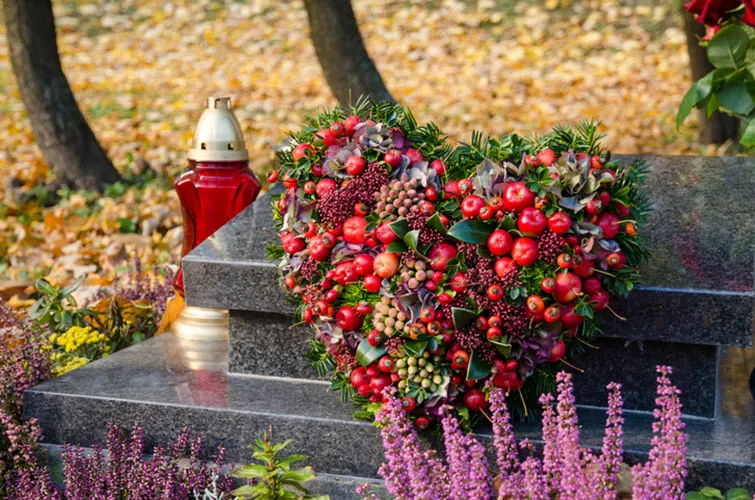Why Do We Decorate Graves with Flowers?

Flowers have adorned graves for centuries, serving as a poignant tribute to those who have passed. This tradition carries a rich tapestry of meanings, rooted deeply in cultural, historical, and psychological elements. In this post, we delve into the reasons behind this age-old custom, exploring how it intertwines with our human need to honor and remember.
Historical Origins


The practice of decorating graves with flowers traces back to ancient civilizations:
- Ancient Egypt: Egyptians used flowers like lotus and papyrus, which symbolized rebirth, in their burials. They believed these plants had a spiritual connection, aiding the soul’s journey in the afterlife.
- Greece and Rome: They decorated the graves of soldiers and loved ones with wreaths made from fresh flowers and vines. This act was a way to honor the deceased and provide for them in the afterlife.
- Celtic and Christian Traditions: The Celts used flowers to signify the cycle of life, while Christians incorporated flowers into graveside rituals to represent the resurrection of Christ, with lilies being a prominent choice.
Cultural Significance

Cultures worldwide have their unique interpretations of why flowers are used:
- Asia: In countries like China and Japan, flowers at graves signify beauty, renewal, and the impermanence of life. White chrysanthemums are popular in Japan for their association with purity and mourning.
- Europe: Easter lilies are common in European cemeteries, symbolizing hope and the soul’s immortality. In Mexico, marigolds are used during Dia de los Muertos to guide spirits back to the world.
- Middle East: Flowers in Middle Eastern cultures often represent life, growth, and the connection between the living and the dead. They are seen as offerings to the deceased, ensuring their comfort in the afterlife.
Psychological and Emotional Aspects

The psychological impact of decorating graves with flowers goes beyond the physical act:
- Expression of Love: Flowers are a universal symbol of love and affection. Placing them on a grave is a way to continue expressing love for the departed.
- Healing and Grief: The act of decorating a loved one’s grave can aid in the mourning process. It offers a sense of peace, providing comfort through the care and maintenance of the grave.
- Remembrance: Flowers serve as a visual reminder of life, prompting memories and stories, which are crucial for keeping the deceased’s memory alive.
The Language of Flowers

In Victorian times, and still today, different flowers convey distinct messages:
| Flower | Meaning |
|---|---|
| Roses | Love, Beauty, Perfection |
| Lilies | Purity, Virtue, Innocence |
| Carnations | Fascination, Divine Love, Motherly Love |

Floriography, or the language of flowers, allows mourners to select blooms that reflect their feelings, creating a silent conversation with the departed.
🌸 Note: The choice of flowers can vary significantly based on personal, cultural, or religious practices. Always consider these when selecting flowers for a grave.
Modern Practices

Today, the practice has evolved:
- Artificial Flowers: These are used for longevity in areas with harsh weather conditions or where natural blooms are not available year-round.
- Wildflower Meadows: Some cemeteries are transforming into wildflower meadows, providing a natural, biodiverse resting place.
- Memorial Plantings: Families often choose to plant trees or shrubs in memory of their loved ones, creating lasting tributes.
The enduring tradition of decorating graves with flowers serves as a poignant reminder of the cycle of life, death, and rebirth. Through this ritual, we express our emotions, honor the past, and symbolically look towards the future. Each flower laid on a grave is a statement of remembrance, an act of love, and a silent promise that the departed are not forgotten.
What are the most common flowers used for grave decoration?

+
Common choices include roses for their enduring symbol of love, lilies for purity, chrysanthemums for their cultural significance, and carnations for their connection to divine love.
How should one choose flowers for a grave?

+
Consider the deceased’s favorite flowers, the cultural or religious significance of certain blooms, the environmental conditions of the site, and the personal meanings or messages you wish to convey.
What is the significance of planting trees or shrubs at graves?

+
Planting trees or shrubs can symbolize growth, longevity, and a connection to nature. It provides a living memorial that grows and changes, much like the memory of the person lives on.
Can I use artificial flowers on a grave?

+
Yes, artificial flowers can be used, especially in harsh climates or where natural flowers are not available year-round. They can provide a lasting tribute, although they lack the natural beauty and symbolism of live plants.
Why do some cemeteries have wildflower meadows?

+
Wildflower meadows in cemeteries offer a natural resting place, increase biodiversity, support pollinators, and provide a peaceful and beautiful environment for visitors to remember their loved ones.